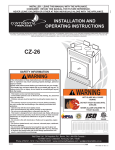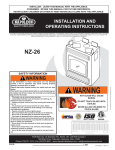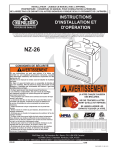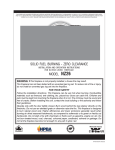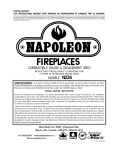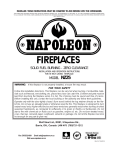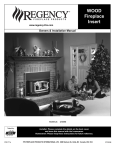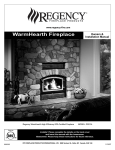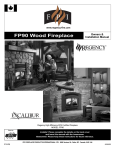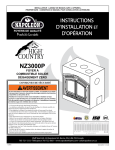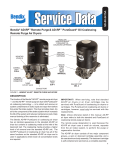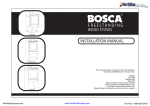Download Napoleon Fireplaces NORTHLINEEXPRESS NZ-26 User's Manual
Transcript
INSTALLER: LEAVE THIS MANUAL WITH THE APPLIANCE. CONSUMER: RETAIN THIS MANUAL FOR FUTURE REFERENCE. 1 INSTALLATION AND OPERATING INSTRUCTIONS THIS FIREPLACE HAS BEEN TESTED AND LISTED BY INTERTEK TESTING SERVICES TO STANDARDS: CAN/ULC S610, UL 127, FOR ZERO CLEARANCE FIREPLACES, AND TO ULC S639 FOR STEEL LINER ASSEMBLIES FOR SOLID FUEL BURNING MASONRY FIREPLACES. CERTIFIED UNDER USA ENVIRONMENTAL PROTECTION AGENCY (E.P.A.) JULY 1990 AND THE OREGON DEPARTMENT OF ENVIRONMENTAL QUALITY (D.E.Q.) PARTICULATE EMISSION STANDARDS NZ-26 SAFETY INFORMATION ! WARNING If the information in these instructions is not followed exactly, a fire or explosion may result causing property damage, personal injury or death. Improper installation, adjustment, alteration, service or maintenance can cause injury or property damage, bodily injury or even death. Please read entire manual before you install and use your fireplace. This fireplace has not been tested with an unvented gas log set. To reduce risk of fire or injury, do not install an unvented gas log set into the fireplace. - This fireplace can be very hot when burning. - Combustible materials such as firewood, wet clothing, etc. placed too close can catch fire. - Children and pets must be kept from touching the fireplace when it is hot. - The chimney must be sound and free of cracks. Before installing this unit, contact the local building or fire authority and follow their guidelines. - Operate only with the door tightly closed. - Burn wood behind the log retainer directly on the firebricks. - Do not use an elevated grate or otherwise raise the fire. - This fireplace is designed to burn natural wood only. Higher efficiencies and lower emissions generally result when burning air dried seasoned hardwoods, as compared to softwoods or to green or freshly cut hardwoods. - Do not start a fire with chemicals or fluids such as gasoline, engine oil, etc. - Do not burn treated wood, coal, charcoal, colored paper, cardboard, solvents or garbage. - Do not let the fireplace become hot enough for any part to glow red. Wolf Steel Ltd., 24 Napoleon Rd., Barrie, ON, L4M 4Y8 Canada / 103 Miller Drive, Crittenden, Kentucky, USA, 41030 (705)721-1212 • fax(705)722-6031 • www.napoleonfireplaces.com • [email protected] W415-0676 / 03.14.08 W415-0676 / 03.14.08 $10.00 NorthlineExpress.com http://www.northlineexpress.com Toll-Free 1-866-667-8454 2 INTRODUCTION ! WARNINGS AND SAFETY PRECAUTIONS W415-0676 / 03.14.08 NorthlineExpress.com http://www.northlineexpress.com Toll-Free 1-866-667-8454 3 TABLE of CONTENTS PG 2-6 INTRODUCTION 16 16 Warnings and Safety Precautions Specifications Warranty Installation Overview General Instructions General Information Care of Glass and Plated Parts 7 Controlling Combustion Air Achieving Proper Draft 17-18 OPERATING INSTRUCTIONS Fuel Loading and Burn Cycle Ash Removal Procedures HI-EFFICIENCY HEATING Five Options 18 Location and Clearances Framing Finishing Enclosure Finishing and Enclosure Alternate Finishing Outside Combustion Air Mantel Clearances Hearth Extension 19-20 REPLACEMENTS Ordering Replacement Parts Replacement Parts Accessories 11-13 CHIMNEY INSTALLATION 14-15 FINAL ASSEMBLY MAINTENANCE Gasket / Baffle Replacement Door Glass Replacement Creosote Formation And Removal Run-Away or Chimney Fire Fire Extinguishers and Smoke Detectors Woodpile Maintenance 8-11 INSTALLATION / FRAMING Adding Chimney Sections Offset Chimney Installation Installing Flashing and Storm Collar Connection to a Masonry Chimney OPTIONAL BLOWER FEATURES 21 TROUBLE SHOOTING 22 SERVICE HISTORY 23-24 NOTES Attaching the Handle Top Firebrick and Baffle Installation NOTE: Changes, other than editorial, are denoted by a vertical line in the margin. Congratulations on the purchase of your hi-tech, high efficiency solid fuel burning fireplace! It has been extensively tested in Canadian and American laboratories. SPECIFICATIONS FIGURE 1 W415-0676 / 03.14.08 NorthlineExpress.com http://www.northlineexpress.com Toll-Free 1-866-667-8454 4 N A P O L E O N ® p r o d u c t s a r e m a n u fa c t u r e d u n d e r t h e s t r i c t S t a n d a rd o f t h e Wo r l d R e c o g n i z e d ISO 9001 : 2000 Quality Assurance Certificate. NAPOLEON® products are designed with superior components and materials, assembled by trained craftsmen who take great pride in their work. The complete fireplace is thoroughly inspected by a qualified technician before packaging to ensure that you, the customer, receives the quality product that you expect from NAPOLEON®. NAPOLEON® WOOD FIREPLACE PRESIDENT'S LIFETIME LIMITED WARRANTY The following materials and workmanship in your new NAPOLEON® wood fireplace are warranted against defects for as long as you own the fireplace. This covers: combustion chamber, heat exchanger, stainless steel baffle retainer, ceramic glass (thermal breakage only), gold plated parts against tarnishing, porcelainized enamelled components, aluminum extrusion trims ash drawer, and cast iron castings. Electrical (110V) components and wearable parts such as blowers, thermal switch, switches, wiring, firebrick, gasketing, and high temperature paint are covered and NAPOLEON® will provide replacement parts free of charge during the first year of the limited warranty. Labour related to warranty repair is covered free of charge during the first year. Repair work, however, requires the prior approval of an authorized company official. Labour costs to the account of NAPOLEON® are based on a predetermined rate schedule and any repair work must be done through an authorized NAPOLEON® dealer. CONDITIONS AND LIMITATIONS NAPOLEON® warrants its products against manufacturing defects to the original purchaser only -- i.e., the individual or legal entity (registered customer) whose name appears on the warranty registration card filed with NAPOLEON® -- provided that the purchase was made through an authorized NAPOLEON® dealer and is subject to the following conditions and limitations: This factory warranty is non-transferable and may not be extended whatsoever by any of our representatives. The wood fireplace must be installed by an authorized service technician or contractor. Installation must be done in accordance with the installation instructions included with the product and all local and national building and fire codes. This limited warranty does not cover damages caused by misuse, lack of maintenance, accident, alterations, abuse or neglect and parts installed from other manufacturers will nullify this warranty. This limited warranty further does not cover any scratches, dents, corrosion or discoloring caused by excessive heat, abrasive and chemical cleaners nor chipping on porcelain enamel parts, nor any venting components used in the installation of the fireplace. In the first year only, this warranty extends to the repair or replacement of warranted parts which are defective in material or workmanship provided that the product has been operated in accordance with the operation instructions and under normal conditions. After the first year, with respect to the President's Limited Lifetime Warranty, NAPOLEON® may, at its discretion, fully discharge all obligations with respect to this warranty by refunding to the original warranted purchaser the wholesale price of any warranted but defective part(s). After the first year, NAPOLEON® will not be responsible for installation, labour or any other costs or expenses related to the reinstallation of a warranted part, and such expenses are not covered by this warranty. Notwithstanding any provisions contained in the President's Limited Lifetime Warranty, NAPOLEON’S responsibility under this warranty is defined as above and it shall not in any event extend to any incidental, consequential or indirect damages. This warranty defines the obligations and liability of NAPOLEON® with respect to the NAPOLEON® wood fireplace and any other warranties expressed or implied with respect to this product, its components or accessories are excluded. NAPOLEON® neither assumes, nor authorizes any third party to assume, on its behalf, any other liabilities with respect to the sale of this product. NAPOLEON® will not be responsible for: over-firing, downdrafts, spillage caused by environmental conditions such as rooftops, buildings, nearby trees, hills, mountains, inadequate vents or ventilation, excessive venting configurations, insufficient makeup air, or negative air pressures which may or may not be caused by mechanical systems such as exhaust fans, furnaces, clothes dryers, etc. Any damages to fireplace, combustion chamber, heat exchanger, brass trim or other component due to water, weather damage, long periods of dampness, condensation, damaging chemicals or cleaners will not be the responsibility of NAPOLEON®. The bill of sale or copy will be required together with a serial number and a model number when making any warranty claims from your authorized dealer. The warranty registration card must be returned within fourteen days to register the warranty. NAPOLEON® reserves the right to have its representative inspect any product or part thereof prior to honouring any warranty claim. ALL SPECIFICATIONS AND DESIGNS ARE SUBJECT TO CHANGE WITHOUT PRIOR NOTICE DUE TO ON-GOING PRODUCT IMPROVEMENTS. NAPOLEON® IS A REGISTERED TRADEMARK OF WOLF STEEL LTD. PATENTS U.S. 5.303.693.801 - CAN. 2.073.411, 2.082.915. © WOLF STEEL LTD. W415-0676 / 03.14.08 NorthlineExpress.com http://www.northlineexpress.com Toll-Free 1-866-667-8454 5 INSTALLATION OVERVIEW FIGURE 2 ! WARNING This fireplace and its components are designed to be installed and operated as a system. Any alteration to or substitution for items in this system, unless allowed by these installation instructions, will void the Warnock Hersey, listing and may void the product warranty. It may also create a hazardous installation. Read through these instructions thoroughly before starting your installation and follow them carefully throughout your project. W415-0676 / 03.14.08 NorthlineExpress.com http://www.northlineexpress.com Toll-Free 1-866-667-8454 6 GENERAL INSTRUCTIONS This is the most efficient, simple and trouble free woodburning system we know of and works as follows: FIGURE 3 Your fireplace must be installed in accordance with all national and local building code standards and the standard of Chimney and Fireplaces, Vents and Solid Fuel Burning Appliances NFPA #211. Consult the authority having jurisdiction (such as municipal building department, fire department, fire prevention bureau, etc.) to determine the need to obtain a permit. If you are in doubt about the proper installation for your situation, contact your dealer or local building or fire official. The manufacturer does not guarantee that this fireplace and its options will completely heat your entire home. Expansion / contraction noises during heating up and cooling down cycles are normal and to be expected. Mobile home installation requires that the fireplace be secured to the floor. It is recommended that in all cases, the fireplace be secured to the floor. Use the pallet packing brackets to accomplish this. CARE OF GLASS AND PLATED PARTS Primary combustion air enters through the air control inlet box regulated by a draft control, travels up the side through a duct and enters the top centre of the combustion chamber into a preheating airwash located across the top and then down the window to feed the fire and also to ensure that the glass remains clean. Secondary air feeds directly into the combustion chamber at hearth level through the log retainer and also through inlets located at the bottom back corners of the combustion chamber. This air travels up the riser to the four secondary air tubes located at the top and shoots out laterally to oxidize the gases rising to the smoke exit. The combustion chamber is lined with high-temperature firebrick on all sides, and across the bottom to maintain a high temperature in the combustion chamber so that gases mixing with the preheated air from the secondary air tubes are easily ignited and burned. The fireplace sides and back permit a zero clearance installation and direct the heat upwards and forwards into the room. Be sure to provide sufficient combustion air. There are many other appliances in your home competing for air such as a kitchen range hood, forced air heating devices or a bathroom exhaust fan. If the outside air feature is utilized, you will never experience a shortage of combustion air. If you choose not to utilize outside air and experience draft or smoking problems, you may need to open a door or window. After extended periods of non-operation such as following a vacation or a warm weather season, the fireplace may emit a slight odour for a few hours. This is caused by dust particles on the firebox burning off. Open a window to sufficiently ventilate the room. If the glass is not kept clean permanent discoloration and / or blemishes may result. Normally a hot fire will clean the glass. The most common reasons for dirty glass include: not using sufficient fuel to get the stove thoroughly hot, using green or wet wood, closing the draft so far that there is insufficient air for complete combustion. If it is necessary to clean the glass, use a soft cloth with a non-abrasive cleaner. Do not clean the glass when hot! The glass is very strong but do not let burning fuel rest or fall against it and always close the door gently. Never force it shut! If the glass should ever crack while the fire is burning, do not open the door until the fire is out and do not operate the stove again until the glass has been replaced with a new 5mm thick piece of ceramic glass, available from your authorized dealer. Do not substitute materials. For information on glass removal and replacement, see Maintenance. Do not use abrasive cleaners to clean plated parts. Buff lightly with a clean dry cloth. Prolonged high temperature burning with the door ajar may cause a permanent rainbowing effect on the lower edge of a gold plated door. NOTE: The protective wrap on plated parts is best removed when the assembly is at room temperature but this can be improved if the assembly is warmed, using a hair dryer or similar heat source. GENERAL INFORMATION CALIFORNIA PROP 65 WARNING: Use of this product may produce smoke which contains chemicals known to the State of California to cause cancer, birth defects, or other reproductive harm. Do not use makeshift compromises during installation. Do not block or restrict air, grille or louvre openings! Do not add a hood. Burning your unit with the ash dump door open or ajar creates a fire hazard that may result in discoloration to the gold plated door, internal damage to the fireplace or a house and/or chimney fire. All venting connections must be in compliance with the chimney manufacturers installation instructions. Clearances referred to throughout this manual are the minimum requirements. When the appliance is equipped with a 24 karat gold-plated door, you must clean all the fingerprints and oils from the gold surface before firing the appliance for the first time. Use a glass cleaner or vinegar and towel to remove the oils. If not cleaned properly before lighting your first fire, the oils can cause permanent markings on the gold plating. After the gold plating is cured, the oils will not affect the finish and little maintenance is required, just wipe clean as needed. W415-0676 / 03.14.08 NorthlineExpress.com http://www.northlineexpress.com Toll-Free 1-866-667-8454 7 HI-EFFICIENCY HEATING FIVE OPTIONS To operate this hi-efficiency fireplace as a basic system, the blower is not required, however, to enhance its efficiency a blower is recommended. ATTIC A BLOWER KIT (NZ62) This blower is installed in the bottom of the unit and used to direct the heat into the room where the fireplace is located. The blower is controlled, by a variable speed switch, located inside the fireplace. BLOWER LOCATION OPTIONS OPTION FOR TYING INTO EXISTING DUCT WORK A THERMOSTATIC AIR CONTROL (NZ690KT) may be used for constant heat, complete with automatic damper and thermostat, wall mounted in the room containing the fireplace, and at least 10 feet (minimum) from the fireplace. A HOT AIR GRAVITY VENT SYSTEM (NZ220) may be used to distribute heat to an adjoining room (located either above, or beside the room containing the fireplace) by way of vents, eliminating the need of an additional blower. While this system may be used in conjunction with the optional blowers, it could reduce the flow of hot air being distributed to additional rooms. It must be experimented with and the dampers adjusted manually to suit your requirements. This may take a few attempts; thereafter adjustments should no longer be required as is normally experienced with your central heating system registers. The heat shield cover plate must be removed before installing the gravity vent. The hot air vent must be installed in an upward direction! NEVER install in a downward direction. Figure 6. The hot air gravity vent system is not to be connected to a central heating system (for this application use the NZ62CH). This option may not be used in mobile homes. No more than two hot air gravity vents can be installed to fireplace. Individual vent runs are not to exceed 10 feet. All hot air gravity vents must be insulated. FIGURE 5b A HOT AIR DISTRIBUTION KIT (GA-566) may be used to distribute warm air from the fireplace base (only) into a separate location in the home. These options may be incorporated with one another. If the optional blowers are to be installed, make provision during framing to route a 110 volt power line to the fireplace. Detailed installation instructions are included with each venting kit. NO DUCTING GRAVITY VENT OPTION (1 DUCT) GRAVITY VENT OPTION (2 DUCTS) GRAVITY VENT OPTION * CENTRAL HEATING CENTRAL HEATING BOTTOM CENTRAL HEATING RIGHT SIDE ONLY CENTRAL HEATING & GRAVITY VENT OPTION HEAT SHIELD COVER PLATE * MASONRY APPLICATION ONLY ! STOVE TOP FIGURE 4 A CENTRAL HEATING SYSTEM (NZ62CH) may be used to heat rooms up to 50 feet from the unit. A wall mounted thermostat located in the room to be heated controls the blower supplying warm air from the room containing the fireplace. If a hot air duct system exists, the central heat blower may safely be tied into this system to reduce the amount of new ducting required. Consult with a heating specialist to ensure a proper duct layout for your home. If the NZ62CH is installed at the bottom of the unit, it could introduce a cool draft into the room that the fireplace is installed in. When attached to the top or sides of the unit, it provides a higher heat output. This option may not be used in mobile homes. FIGURE 6 WARNING Do not draw outside air from garage spaces. Exhaust products of gasoline engines are hazardous. Do not install outside air ducts such that the air my be drawn from attic spaces, basements or above the roofing where other heating appliances or fans and chimneys exhaust or utilize air. These precautions will reduce the possibility of fireplace smoking or air flow reversal. The outside air inlet must remain clear of leaves, debris ice and/or snow. It must be unrestricted while unit is in use to prevent room air starvation which can cause smoke spillage and an inability to maintain a fire. Smoke spillage can also set off smoke alarms. To prevent contact with sagging or loose insulation, the fireplace must not be installed against vapour barriers or exposed insulation. Localized overheating could occur and a fire could result. FIGURE 5a W415-0676 / 03.14.08 NorthlineExpress.com http://www.northlineexpress.com Toll-Free 1-866-667-8454 8 INSTALLATION / FRAMING ! WARNING Before starting, do the following: 1. For protection wear gloves and safety glasses. 2. Keep hand tools in good condition, sharpen cutting edges and make sure tool handles are secure. 3. Always maintain the minimum air space required to the enclosure to prevent fires. ! MAINTAIN THESE MINIMUM CLEARANCES TO COMBUSTIBLES: Fireplace framing: Top Stand-Off 0" Rear Stand-Off 0" Side 6" Fireplace finishing: Sides 63/4" Top 63/4" Factory Built Chimney 2" Hot Air Gravity Ductwork Insulation 1" *Base of unit to ceiling 72" 72" *Base of unit to enclosure top Enclosure must have ventilation between 72" and 84" WARNING Carefully follow the instructions for assembly of the chimney and other parts needed to install this fireplace. Failure to do so may result in a fire, especially if combustibles are too close to the fireplace or chimney and air spaces are blocked, preventing the free movement of cooling air. LOCATION AND CLEARANCES Do not build shelves or cupboards into the area above the fireplace. While the fireplace can be installed directly on the floor, a noncombustible hearth extension is required in front of the fireplace, that must not be built higher than the bottom of the fireplace to avoid air flow blockage. It may therefore be advisable to build the fireplace on a raised platform. The minimum distance between the edge of the fireplace and any adjacent wall, at right angles to it, is 21". A wall projecting at 45° from the outer edge of the fireplace is allowed; projections into this area are permitted. Do not install into any area having a height less than 6 feet (ceiling to fireplace base, excluding hearth height). See Section on Framing. The location of windows, doors and the traffic flow in the room where the stove is to be located should be considered. If possible, you should choose a location where the chimney will pass through the house without cutting a floor or roof joist. FIGURE 7a: Framing Requirements ! WARNING *84" if installing optional hot air gravity vent system, NZ220 on the same floor as the fireplace. FRAMING NOTE: In order to avoid the possibility of exposed insulation or vapour barrier coming in contact with the fireplace body, it is recommended that the walls of the fireplace enclosure be “finished” (i.e.: drywall/sheetrock), as you would finish any other outside wall of a home. This will ensure that clearance to combustibles is maintained within the cavity. NOTE: Do not build into this area - it must be left clear to provide adequate clearance for the vent in this 14” wide area centered along the front of the fireplace. No combustibles are allowed. 3 1/2” MAX 72” MINIMUM ENCLOSURE HEIGHT FIGURE 7b 14” MAX 1 1/2” MAX 25 3/4” 44 3/4” 50 3/4” W415-0676 / 03.14.08 NorthlineExpress.com http://www.northlineexpress.com Toll-Free 1-866-667-8454 9 The fireplace should be framed using 2x4 lumber. For the header and cripple studs above the fireplace it is recommended to use steel. The fireplace must be secured to the floor in all cases. Use the pallet packing brackets to secure to the floor. If ducting is to be installed, the minimum enclosure ceiling height is 84". Without ducting, the ceiling height may be brought down to a minimum of 72". However a fireplace enclosure with a height less than 84" must be provided with sufficient air circulation to avoid a fire hazard. Install ventilation grilles (minimum openings of 40 sq. inches) at both floor and ceiling levels of the enclosure. Do not place insulation into the enclosure around the fireplace or the chimney. Combustible framing materials must not be closer than 6" from the side of the unit and 5" from the top of the unit. FIGURE 7c: Finishing Requirements FINISHING Clearances to finishing materials: 6 3/4" minimum of non-combustible material to the top of the unit and a minimum 6 3/4" to either side. Objects placed in front of the fireplace must be kept a minimum of 48" away from the front face of the unit. Non-combustible material (brick, stone, cement board or ceramic tile) may protrude over the black painted surface of the fireplace front. W415-0676 / 03.14.08 NorthlineExpress.com http://www.northlineexpress.com Toll-Free 1-866-667-8454 NorthlineExpress.com http://www.northlineexpress.com 12” MAXIMUM FIGURE 8a 1” OPEN VENTILATION REQUIRED IN ENCLOSURES BETWEEN 72” AND 84” 72” MINIMUM ENCLOSURE HEIGHT 1” OPEN FIGURE 8b ENCLOSURE ALTERNATE FINISHING NOTE: As an alternate to grates a 1" x 40 inches wide gap can be left in the bottom and top of any finishing material to circulate the air from the floor, around the fireplace through the enclosure and out the top. If utilizing this method, ensure the fireplace is properly supported and support method does not restrict the flow of air. Minimum 40 square inches of ventilation opening required, both at the top and bottom of the enclosure. Ventilation openings are required in enclosures up to 84” high. They are recommended for all enclosures. VENTILATION REQUIRED IN ENCLOSURES BETWEEN 72” AND 84” 72” MINIMUM ENCLOSURE HEIGHT 12” MAXIMUM ENCLOSURE FINISHING 10 W415-0676 / 03.14.08 Toll-Free 1-866-667-8454 11 OUTSIDE COMBUSTION AIR Model NZ-26 has the option of taking outside air directly into the fireplace through the opening on the left hand side or taking inside air through the lower front louvres or a combination of both. If the optional fresh air kit (available through your authorized dealer) is installed, it must not draw air from the attic or garage. It may only come from outside the house. The maximum length of the 4" air duct is 20 feet; thereafter enlarge the duct to a 6" diameter. Decide on the most convenient location for the fresh air inlet duct and hood which may be installed above or below floor level. Make a 5" hole in an outside wall of the house. From outside, place the fresh air hood into the hole, open side down. At each end, carefully pull back the insulation sleeve exposing the flexible duct. Place the insulated flexible duct over the fresh air hood and over the fireplace outside air connector. Carefully push the insulation sleeve back over the duct. Using the clamps, fasten the insulated duct into place on both sides. Figure 9. For outside air only, re-install the inside air cover plate, shown in Figure 37, to cover the control box inside air opening. See Section on Combustion Air Control. A chimney venting the fireplace shall not vent any other appliance. A chimney venting the fireplace shall not vent any other appliance. MANTEL CLEARANCES Mantel clearance can vary according to the mantel depth. FIGURE 10 HEARTH EXTENSION An acceptable 16" x 50" non-combustible (i.e.: brick, stone or ceramic tile) hearth extension must be installed. Ensure that the gap between the fireplace and a factory-built hearth extension is sealed with sand/ cement grout or covered with a metal strip (or both) to prevent sparks and embers from falling into this area. A raised hearth together with the fireplace built on a raised platform is recommended for easier wood loading and fire viewing. ! FIGURE 9 WARNING Hearth extensions are to be installed only as described to prevent high temperatures from occurring on concealed combustible materials. Hearth sealing strips prevent burning or hot particles from inadvertently falling directly on combustible surfaces in the event the building should settle and disturb the original construction. CHIMNEY INSTALLATION ! If the chimney system is enclosed within the attic area, a rafter radiation shield is required. WARNING Never install a single wall slip section or smokepipe in a chase structure. The higher temperature of this single wall pipe may radiate sufficient heat to combustible chase materials to cause a fire. To avoid danger of fire, all instructions must be strictly followed, including the provision of air space clearance between chimney system and enclosure. To protect against the effects of corrosion on those parts exposed to the weather, we recommend that the chase top be painted with a rust-resistant paint. Maintain a minimum 2" air clearance to all parts of the chimney system at all times. Failure to maintain this 2" air clearance will cause a structure fire. Detailed instructions for installation of the chase top, storm collar and termination cap are packaged with these parts. Firestop spacers must be used whenever the chimney penetrates a ceiling/floor area. A chimney venting the fireplace shall not vent any other appliance. The minimum overall chimney height from the top of the fireplace is 11 feet. The maximum overall chimney height from the top of the fireplace is 34 feet. Factory-built chimney systems for use in dwellings constructed for three or more families must be enclosed above the room in which the fireplace is located. This enclosure must have a fire resistance rating equal to or greater than that of the floor or roof assembly through which they pass. The chimney must extend at least 3 feet above its point of contact with the roof and at least 2 feet higher than any wall, roof or building within 10 feet. If the chimney extends more than 5 feet above the roof, it must be secured using a roof brace or guide wires. Ensure that minimum clearances are maintained Portions of the chimney that extend through accessible spaces must always be encased to avoid personal contact with the chimney and thereby avoid damage to the chimney. A raincap must be installed to avoid internal damage and corrosion. The chimney must be supported at a maximum of 20 foot intervals (approx. 200 lbs/20 ft). The NZ-26 was tested to CAN/ULC S610 and UL 127 Factory Built Fireplace Standards. This fireplaces has met the test criteria for Zero Clearance Installation to Combustible Surfaces and Certified to burn Firewood only. Any 6" diameter chimney listed to these standards may be installed. In accordance with these standards, the unit may also be connected to any chimney listed to CAN/ULC-S609 and ULC-S629 for Canada or UL-103HT for the United States. Installation of all types of factory-built chimney systems is to be in accordance with the chimney manufacturers installation instructions. An appropriate chimney manufacturers anchor base plate and anchor base plate gasket is required in order to initiate the twist lock mechanism. Use the high temperature gasket, supplied, to seal between the anchor plate and the fireplace top. W415-0676 / 03.14.08 NorthlineExpress.com http://www.northlineexpress.com Toll-Free 1-866-667-8454 12 FIGURE 11 - STRAIGHT UP FIGURE 12 - 2 ELBOWS FIGURE 13 - 4 ELBOWS No Off-Set. Minimum overall chimney height is 11 feet. Single off-set with two 15°, 30° or 45° elbows. Minimum overall chimney height is 11 feet. Double off-set with four 15°, 30° or 45° elbows. Minimum overall chimney height is 11 feet. * The first flue offset closest to the top of the unit must be a minimum distance of 12" from the top of the fireplace. 1. Move the fireplace into position. Try to centre the exhaust flue of the fireplace, midpoint between two joists to prevent having to cut them. Use a plumb bob to line up the centre. 2. Cut and frame an opening in the ceiling to provide a minimum clearance of 2" between the outside of the chimney and any combustible material. DO NOT FILL THIS SPACE WITH ANY TYPE OF MATERIAL! Nail headers between the joists for extra support. Firestop spacers must be placed on the bottom of each framed opening in any floor or ceiling that the chimney passes through. 3. Hold a plumb bob from the underside of the roof to determine where the opening in the roof should be. Cut and frame the roof opening maintaining proper 2" clearances. NOTE: 30° or 45° offsets may be installed back to back. ADDING CHIMNEY SECTIONS Add chimney sections, twist locking (clockwise) securely, to the required height. Use a rafter radiation shield whenever the chimney system is enclosed within an attic area. FIGURE 16 FIGURE 14 OFFSET CHIMNEY INSTALLATION FIGURE 15 The first flue offset closest to the top of the unit must be a minimum distance of 12" from the top of the fireplace. An insulated elbow must be used when it becomes necessary to offset the chimney in order to clear a joist or to pass through an upstairs closet. Attach an elbow to the chimney section, angled toward the offset. Secure with 3 - #8X1/2" sheet metal screws. To achieve the minimum offset, attach and secure a return elbow to the first. To achieve longer offsets, you may install any available length of chimney pipe between the elbows. Supports must be used on the first vertical chimney section after a return elbow. ! WARNING Chimney sections installed between an offset and return require structural support to reduce off-center loading and to prevent chimney sections from separating at the chimney joints. The chimney should not be built with an offset angle in excess of 45° in Canada and 30° in USA. Do not combine offset chimney components to exceed these angles. W415-0676 / 03.14.08 NorthlineExpress.com http://www.northlineexpress.com Toll-Free 1-866-667-8454 13 IF THE CHIMNEY IS UNLINED: FIGURE 17 INSTALLING FLASHING AND STORM COLLAR Remove the nails from the shingles above and to the sides of the chimney. Place the flashing over the chimney pipe and slide underneath the sides and upper edge of the shingles. Ensure that the chimney pipe is properly centered within the flashing, giving a 3/4" margin all around. Fasten to the roof on the top and sides. DO NOT NAIL through the lower portion of the flashing. Make weather-tight by sealing with caulking. Where possible, cover the sides and top edges of the flashing with roofing material. Apply waterproof caulking, provided with the flashing, around the chimney, 1" above the top of the flashing and push the storm collar down into the caulking. Insert a rain cap onto the top of the last chimney section. A stainless steel liner listed to either Standard ULCS640M, ULC-S639 in Canada or UL-1777 in the USA: Liners for New Masonry Chimneys, may be used to connect the fireplace to the chimney. The liner must be continuous from the fireplace to the chimney cap and be installed only per manufacturers instructions. Figure 19. In both FIGURE 20 cases, the chimney structure must be supported by angle iron anchored into the masonry walls. Figures 19 & 20. The allowable masonry used in chimney construction is 3-1/2" brick, solidly mortared and fully encasing the flue. Ensure there are no leaks. In no case is the masonry enclosure to be supported by the NZ-26 fireplace. Allow a 1" (one inch) air cavity for expansion. FIGURE 18 ANCHOR PLATE HI-TEMP GASKET FIREPLACE TOP FIGURE 21 FLUE TILE SUPPORT FOR A MASONRY FIREPLACE CONNECTION TO A MASONRY CHIMNEY Model NZ-26 may be connected to either a lined or unlined masonry chimney. IF THE CHIMNEY IS LINED, the flues must be made of vitrified clay and be in sizes of 8" square, 8" x 12", or 8" round with a minimum height of 11 feet above the fireplace. 8" round flues are recommended. Installation must conform to both national and local code requirements. HI-TEMP GASKET FIREPLACE TOP FIGURE 22 For a masonry fireplace use a flue tile support. For a pre-fabricated chimney use an anchor plate. FIGURE 19 W415-0676 / 03.14.08 NorthlineExpress.com http://www.northlineexpress.com Toll-Free 1-866-667-8454 14 FINAL ASSEMBLY ATTACHING THE HANDLE Attach the handle as shown so that when the door is closed, the handle will be centred in the slot located on the fireplace front. To achieve this you may have to experiment (on the upper and lower screws) with one of the variations shown. Tighten securely. TOP FLAME SPREADER BOTTOM FLAME SPREADER FIBRE BAFFLE (1 OF 2 SHOWN) TOP FIREBRICK (1 OF 2 SHOWN) FIGURE 23 FIGURE 24 FIGURE 28 3a ! FIGURE 25 TOP FIREBRICK AND BAFFLE INSTALLATION WARNING Operation of the fireplace without the top firebricks and the baffles can result in excessive temperatures that could damage the fireplace, chimney and the surrounding enclosure. The fireplace is shipped with the firebricks in place. Top firebricks, fibre baffles and gasket rope are not installed. BAFFLE SUPPORT BRACKET FIBRE BAFFLE TOP FIREBRICK TUBE TUBE RETAINER FIGURE 26 1 1 Unscrew and remove the front tube retainer. Note that the first tube retainer also holds the side brick in place. Slide the tube either to the left or right and remove. Remove the two middle tubes in the same fashion. 1 3b FIGURE 29 Insert the left baffle, then the left top firebrick. Repeat using the right baffle and brick. The baffles are made of a brittle material. Care must be taken not to bend or force them. Replace the three front tubes. Position the center edges of both baffles and bricks until they lie snugly together. Slide the baffle support bracket into place along the front of the unit between the front tube and the two top firebricks. 3 REAR BRICKS GASKET ROPE LOCATION 2 2 FIGURE 27 Place gasket rope along the upper ledge of the air chamber and on the top of the rear bricks. The top and bottom flame spreaders come taped together. This tape will burn away in the initial firing of the unit. On subsequent brick removals, the bottom flame spreader must be taped to the top spreader to ease top brick and baffle removal and to avoid damaging the fibre baffles. 4 FIGURE 30 W415-0676 / 03.14.08 NorthlineExpress.com http://www.northlineexpress.com Toll-Free 1-866-667-8454 15 If you need to remove the bricks (to lighten the fireplace for ease of installation, replacement, etc), follow this sequence: For Firebrick Removal: Remove the ashwell grate. This allows the four bottom bricks to be removed first. Slide out the baffle support bracket from above the front tube. Reaching above the top firebricks and baffles, lift and tape the bottom flame spreader to the top spreader to ease top brick and baffle removal and to avoid damaging the fibre baffle. Remove the three front tubes. Remove the top firebrick on the right, then the left firebrick. Remove the baffles, starting with the right side. Remove the gasket rope. Check the rope for deterioration and replace if necessary. Remove the rear bricks (pull the two bricks forward at the centre, and lift the bottom of the bricks out). Remove the side bricks (tilt the tops inward). 4 FIGURE 31 TOP FLAME SPREADER BOTTOM FLAME SPREADER FIBRE BAFFLES TOP FIBREBRICKS BAFFLE SUPPORT TUBE BURNERS GASKET GASKET LEFT SIDE FIBREBRICK REAR FIBREBRICKS RIGHT SIDE FIBREBRICK BOTTOM LEFT FIBREBRICK BOTTOM RIGHT FIBREBRICK LEFT FRONT FIBREBRICK RIGHT FRONT FIBREBRICK W415-0676 / 03.14.08 NorthlineExpress.com http://www.northlineexpress.com Toll-Free 1-866-667-8454 16 OPTIONAL BLOWER INSTALLATION WARNING ! INSTALLATION TO BE DONE BY A QUALIFIED INSTALLER and must be electrically connected and grounded in accordance with local codes. In the absence of local codes, use the current CSA C22.1 CANADIAN ELECTRICAL CODE in Canada or the ANSI/NFPA 70 NATIONAL ELECTRICAL CODE in the United States. 1. Turn off any electrical power to the fireplace (if applicable). Open the lower louvred control door. 2. Locate the vibration reducing pad over the two threaded studs, piercing 2 holes into the pad. The fan must be installed on the left hand side of the fireplace entirely on the pad. 3. Slide the fan to the back of the fireplace taking care not to damage the terminals. Position the fan onto the studs and secure using the lock washers and wing nuts provided. Pull the leads to the front and right side of the ashpan housing. 4. Remove the junction box. Use a nut connector to attach the black wires of the variable speed switch and the power. 5. Pass the two fan leads and one thermodisc lead through the junction box bushing. FIGURE 32 The thermodisc is located inside the outer shell, just above the louvre door. Connect one fan lead to the thermodisc lead and the other fan lead to the white wire of the variable speed switch using nut connectors. 6. Thread the other thermodisc lead through the junction box bushing and connect to the white wire of the power cord using a nut connector. Secure ground wire (green) to the threaded weld stud located on the junction box wall. Reposition the junction box. Verify that the wires will not interfere with the fan. BECAUSE THE BLOWER IS THERMALLY ACTIVATED, WHEN TURNED ON, IT WILL AUTOMATICALLY START APPROXIMATELY 15-45 MINUTES AFTER LIGHTING THE FIREPLACE. USE OF THE FAN INCREASES THE OUTPUT OF HEAT. Drywall dust will penetrate into the blower bearings causing irreparable damage and must be prevented from coming into contact with the blower or its compartment. Any damage resulting from this condition is not covered by the warranty policy. FIGURE 33 BLOWER WING NUT & LOCK WASHER VIBRATION REDUCING PAD THERMODISC VARIABLE SPEED SWITCH FAN JUNCTION BOX FEATURES CONTROLLING COMBUSTION AIR ! WARNING Fireplace operation does require air. Do not take air from other fuel burning appliances which can result in improper venting (smoking) or air dilution. Always provide adequate makeup air. If the outside combustion air kit is not used, air may still be drawn directly into the fireplace through the lower louvres. Outside and inside air may be combined by pulling the outside air lever out as far as possible, and turning the lever 90° to its locking position. Should you find a frost build up on the air control box or a draft from the fireplace, close the outside air lever when the fireplace is not in use. Air control box is shipped with inside air cover plate in open position. ACHIEVING PROPER DRAFT Draft is the force which moves air from the fireplace up through the chimney. The amount of draft in your chimney depends on the length of the chimney, local geography, nearby obstructions and other forces. Adjusting the draft control regulates the temperature. The draft can be adjusted from a low burn rate with the handle at the bottom setting to a fast burn rate with the handle at the top setting. Inadequate draft may cause back-puffing into the room and may cause plugging of the chimney. Too much draft may cause an excessive temperature in the fireplace, glowing red fireplace parts or an uncontrollable burn which can all lead to a chimney fire or a permanent damage to the unit. Do not operate your fireplace for longer than 30 minutes with the draft control on 'HIGH' (fully open). FIGURE 34 W415-0676 / 03.14.08 NorthlineExpress.com FIGURE 35 http://www.northlineexpress.com Toll-Free 1-866-667-8454 17 OPERATING INSTRUCTIONS Remove all source of gasoline or other flammable vapours and liquids in the vicinity of this or other appliances prior to lighting. Ensure that the top firebricks and fibre baffles are in place and not lifted up. When first installed, the fireplace and the steel are cold and must become hot before the fireplace will function well. During the break-in period (the first 2 or 3 fires) create only small, hot fires using kindling; this will allow the firebrick to cure. Do not be alarmed if small hairline cracks develop in the firebrick. This is a normal occurrence and does not pose a safety hazard. The paint may also smell a little for the first few fires as it cures and you may wish to open a door or window to alleviate the smell. To start, a brisk fire is required. Place loosely crumpled paper on the floor of the fireplace behind the log retainer and cover with dry kindling. Open the draft control fully by moving the lever to "HIGH". Light the paper and leave the door slightly ajar (one inch) until all kindling is burning. To maintain a brisk fire, a hot coal bed must be established and maintained. Slowly add larger wood (2x4 size pieces). Lay the pieces lengthwise from side to side in the hot coal bed with a shallow trench between, so that the primary air can flow directly into this trench and ignite the fuel above. When the fire seems to be at its peak, medium sized logs may be added. Once these logs have caught fire, carefully close the door. Closing the door too quickly after refuelling will reduce the firebox temperature and result in an unsatisfactory burn. Remember it is more efficient to burn medium sized wood, briskly, and refuel frequently than to load the fireplace with large logs that result in a smouldering, inefficient fire and dirty glass. As soon as the door is closed, you will observe a change in the flame pattern. The flames will get smaller and lazier because less oxygen is getting into the combustion chamber. The flames, however, are more efficient. The flames will remain lazy but become larger again as soon as the firebricks have been heated thoroughly and the chimney becomes heated and provides a good draft. At this point, the roaring fire that you see when the door is opened is wastefully drawing heated room air up the chimney -- certainly not desirable. So always operate with the door fully closed once the medium sized logs have caught fire. You can now add larger pieces of wood and operate the fireplace normally. Once the fireplace is entirely hot, it will burn very efficiently with little smoke from the chimney. There will be a bed of orange coals in the firebox and secondary flames flickering just below the top of the firebox. You can safely fill the firebox with wood to the top of the door. Can't get the stove operating? Use more kindling and paper. Assuming the chimney and vent are sized correctly and there is sufficient combustion air, the lack of sufficiently dry quantities of small kindling is the problem. Thumb size is a good gauge for small kindling diameter. Can't get heat out of the stove? One of two things may have happened. The fireplace door may have been closed prematurely and the fireplace itself has not reached optimum temperature. Re-open the door and/or draft control to re-establish a brisk fire. The other problem may have been wet wood. The typical symptom is sizzling wood and moisture being driven from the wood. ! FUEL LOADING AND BURN CYCLE For maximum efficiency, when the fireplace is thoroughly hot, load it fully to the top of the door opening and burn at a medium low setting. The bricks will be nearly all white and the glass mostly clear. The whiteness of the bricks and the cleanness of the glass are good indicators of your operating efficiency. Not enough heat is produced when only one or two pieces of wood are burned. A minimum of three pieces are needed to encase a bed of coals that sustains the fire. Loosely stacked wood burns quicker than a tightly packed load. Wood burns in cycles rather than giving a steady output of heat. It is best to plan these cycles around your household routine so that only enough coals are left to start the next load. In the evening, load your fireplace, at least, a half-hour before bed to ensure the fire is hot enough to close the draft control for an overnight burn. Burn only dry seasoned wood. It produces more heat and less soot or creosote. Do not burn ocean beach wood. Its salt content can produce a metal eating acid. When refuelling open the door slowly to prevent smoke spillage. Use a pair of long fireplace gloves when feeding the fire. Keep a small steel shovel nearby to use as a poker and to remove ashes. Do not store wood within 3 feet (1m) of the fireplace. FLASH FIRES: A flash fire is a small fire burned quickly when you don't need much heat. After your kindling has "caught", load at least 3 pieces of wood, stacked loosely. Burn with the draft control fully open or closed only slightly. EXTENDED FIRE: Load your larger pieces of wood compactly, packed close enough to prevent the flames from penetrating it completely. After approximately 30 minutes, depending on the size of the load, close the draft control completely making sure that the fire is not extinguished. DO NOT OVERFIRE THE FIREPLACE! Overfiring can occur by: a) burning large amounts of smaller wood pieces such as furniture scraps, skids or treated wood; b) vigorously burning large loads of wood with the draft control on "HIGH" (fully open) for long periods of time (one or two hours). ! WARNING Do not store fuel within the clearance to combustibles, or in the space required for re-fueling and ash removal. Burning wet, unseasoned wood can cause excessive creosote accumulation. When ignited it can cause a chimney fire that may result in a serious house fire. Never use gasoline-type lantern fuel, kerosene, charcoal lighter fluid, or similar liquids to start or "freshen up" a fire in this fireplace. Keep all such liquids well away from the fireplace. WARNING This fireplace has not been tested with any vented or unvented gas log set. To reduce risk of fire or injury, do not install a vented or unvented gas log set into fireplace. Always operate this appliance with the door closed and latched except during start-up and re-fueling. Do not leave the fire unattended when the door is unlatched. Unstable firewood could fall out of the firebox creating a fire hazard to your home. W415-0676 / 03.14.08 NorthlineExpress.com http://www.northlineexpress.com Toll-Free 1-866-667-8454 18 ASH REMOVAL PROCEDURES A bed of ashes approximately 1" deep should be left on the firebox bottom to help maintain a hot charcoal bed. When the fire has burned down and cooled, remove any excess ashes. To use your ash pan, pull the ash dump handle forward to an open position. Rake the excess ashes over the grate and into the ash pan. Close the ash well. FIGURE 36 Never operate your fireplace with the ash well in an open position! This creates a fire hazard that may result in a house/chimney fire, internal damage to the stove or discoloration to the gold plated door (plated finishes are not covered by the warranty). To ensure that the ash well is fully closed, allow the door to snap shut, dislodging anything that may be stuck at the opening. Flip the cover up onto the ash pan when transporting the ashes to a closed container with a tight fitting lid for storage. Carry the ash pan using the front and back handles. Keep the closed container on a non-combustible floor or ground, well away from all combustible materials. The ashes should be retained in the closed container until all cinders have thoroughly cooled. Cold wood ashes can be used on the garden or compost. MAINTENANCE GASKET / BAFFLE REPLACEMENT At the end of each burning season inspect the baffle located above the secondary air tubes for deterioration. Replace if necessary. At this time also check that the door gasket is not worn or loose. Replace with 1/2" fibreglass rope if necessary. DOOR GLASS REPLACEMENT To remove the door, open and lift out; remove the screws and brackets holding the glass in place. Remove all broken glass. Wrap the edges of the new glass with a U-shaped strip of fibreglass gasket, covering 1/4" on each side. Place this gasketed glass in position and replace the brackets and screws. When finished, you should be able to move the glass slightly, horizontally and vertically. CREOSOTE FORMATION AND REMOVAL When wood is burned slowly, it produces tar and other organic vapours which combine with expelled moisture to form creosote. These vapours condense in the relatively cooler chimney flue of a slow burning fire and when ignited, make an extremely hot fire. So, the chimney should be inspected monthly during the heating season to determine if a build-up has occurred. If creosote has accumulated it should be removed to reduce the risk of a chimney fire. RUN-AWAY OR CHIMNEY FIRE Run-away fires can be the result of FOUR major factors: 1. Using incorrect fuel, or small fuel pieces which would normally be used as kindling. 2. Leaving the door ajar too long and creating extreme temperatures as the air rushes in the open door. 3. Burning your fireplace with the ash dump door open. 4. Improperly installed or worn gaskets. SOLUTIONS: 1. Do not burn treated or processed wood, coal, charcoal, coloured paper or cardboard. 2. Be careful not to overfire the unit by leaving the door open too long after the initial start-up. 3. Always operate the fireplace with the ash well in a closed position. 4. Replace worn, dried out (inflexible) gaskets. WHAT TO DO IF A RUN-AWAY OR CHIMNEY FIRE STARTS: 1. Close the draft fully (lowest position). 2. Call the local fire department. 3. Examine the chimney, attic and roof of the house, to see if any part has become hot enough to catch fire. If necessary spray with a fire extinguisher or water from a garden hose. 4. Do not operate the stove again until you are certain the chimney has not been damaged. ! WARNING A chimney fire can permanently damage your chimney system. This damage can only be repaired by replacing the damaged component parts. Chimney fires are not covered by the Limited Lifetime Warranty. FIRE EXTINGUISHERS AND SMOKE DETECTORS All homes with a solid fuel burning fireplace should have at least one fire extinguisher in a central location, known to all, and at least one smoke detector in the room containing the fireplace. If it sounds an alarm, correct the cause but do not de-activate or relocate the smoke detector. WOODPILE MAINTENANCE Burn only dry, clean unpainted wood that has been seasoned. It produces more heat and less soot or creosote. Freshly cut wood contains about 50% moisture while after proper seasoning only about 20% of the water remains. As wood is burned, this water boils off consuming energy that should be used in heating. The wetter the wood, the less heat is given off and the more creosote is produced. Both hardwood and softwood burn equally well in this fireplace but hardwood, which is denser, will weigh more per cord and burn a little slower and longer. Firewood should be split, stacked in a manner that air can get to all parts of it and covered in early spring to be ready for burning that fall. Dry firewood has cracks in the end grain. W415-0676 / 03.14.08 NorthlineExpress.com http://www.northlineexpress.com Toll-Free 1-866-667-8454 19 REPLACEMENTS Contact your dealer for questions concerning prices and availability of replacement parts. Normally all parts can be ordered through your Authorized dealer or distributor. When ordering replacement parts always give the following information: 1. 2. 3. 4. 5. MODEL & SERIAL NUMBER OF FIREPLACE INSTALLATION DATE OF FIREPLACE PART NUMBER DESCRIPTION OF PART FINISH ! WARNING Failure to position the parts in accordance with these diagrams or failure to use only parts specified approved with this appliance may result in property damage or personal injury. * IDENTIFIES ITEMS WHICH ARE NOT ILLUSTRATED. FOR FURTHER INFORMATION, CONTACT YOUR AUTHORIZED DEALER. FOR WARRANTY REPLACEMENT PARTS, A PHOTOCOPY OF THE ORIGINAL INVOICE WILL BE REQUIRED TO HONOUR THE CLAIM. REPLACEMENT PARTS ACCESSORIES # PART NO. DESCRIPTION # PART NO. DESCRIPTION 1 2 3 4 5 6 7 8 9 10 11 12 13 14 15 16 17 18 19 20 21 W010-0243 W325-0028 W090-0044 W090-0045 W090-0039 W090-0042 W090-0043 W090-0041 W090-0040 W090-0037 W090-0038 W018-0063 W018-0064 KB35 W690-0002 W018-0060 W010-1072 W562-0010 W562-0016 W325-0007 W325-0002 22 23 24 25 26 27 28 29 30 31 32 111KT NZ 690KT NZ 62 CH* NZ62* NZ 220 GA-566 GA-70 W175-0002* W010-0067* NZ-FTS* NZ 220-2* 33 W410-0005* 34 35 36 37 37 37 38 38 38 38 39 40 H333 H333G H333SS H334 H334G H334SS NZLPB NZLK NZLG NZLSS CFSK-B AK-5 ASH PAN WITH LID ASH PAN HANDLE RIGHT FRONT FIREBRICK LEFT FRONT FIREBRICK REAR FIREBRICK - 2 REQUIRED BOTTOM RIGHT FIREBRICK BOTTOM LEFT FIREBRICK RIGHT SIDE FIREBRICK LEFT SIDE FIREBRICK LEFT UPPER FIREBRICK BAFFLE RIGHT UPPER FIREBRICK BAFFLE RIGHT FIBRE BAFFLE LEFT FIBRE BAFFLE VARIABLE SPEED CONTROL HEAT SENSOR BAFFLE SUPPORT DOOR C/W GLASS & GASKET DOOR GASKET GLASS GASKET LARGE SPRING HANDLE SMALL SPRING HANDLE OUTSIDE AIR KIT THERMOSTATIC AIR CONTROL KIT CENTRAL HEATING KIT BLOWER KIT HOT AIR GRAVITY VENT KIT - 5 FT. HOT AIR DISTRIBUTION KIT EXTENSION KIT - 5 FT FLEXIBLE PIPE COUPLER - 8" DIA. FLEXIBLE VENT SUPPORT ASSEMBLY FLUE TILE SUPPORT ASSEMBLY HOT AIR GRAVITY VENT EXTENSION KIT - 5 FT. C/W INSULATION SLEEVE 10FT FLEXIBLE ALUMINUM AIR VENT - 8" DIA. (FOR USE WITH NZ62CH) ARCHED BLACK DOOR C/W HANDLE & GASKET ARCHED GOLD PLATED DOOR C/W HANDLE & GASKET ARCHED STAINLESS STEEL DOOR C/W HANDLE & GASKET WEBBED BLACK DOOR C/W HANDLE & GASKET WEBBED GOLD PLATED DOOR C/W HANDLE & GASKET WEBBED STAINLESS STEEL DOOR C/W HANDLE & GASKET UPPER & LOWER LOUVRE ASSEMBLY- POLISHED BRASS UPPER & LOWER LOUVRE ASSEMBLY - BLACK UPPER & LOWER LOUVRE ASSEMBLY - GOLD PLATED UPPER & LOWER LOUVRE ASSEMBLY - SATIN CHROME CAST FIREPLACE SURROUND KIT ADAPTER KIT, CAST SURROUND W415-0676 / 03.14.08 NorthlineExpress.com http://www.northlineexpress.com Toll-Free 1-866-667-8454 20 W415-0676 / 03.14.08 NorthlineExpress.com http://www.northlineexpress.com Toll-Free 1-866-667-8454 21 TROUBLE SHOOTING GUIDE BUILD YOUR FIRE ON THE FLOOR OF THE FIREBOX AND BEHIND THE LOG RETAINER ONLY. Do not block or restrict the hot air outlets or air inlets. This will cause the fireplace to overheat. Keep fires away from the door. DOs: 1. 2. 3. 4. 5. 6. Build a hot fire. Use only dry wood Several pieces of medium sized wood are better than a few big pieces. Clean the chimney regularly. Refuel frequently using medium sized wood. "Fine Tune" the air settings for optimum performance. DON'Ts: 1. 2. 3. 4. 5. Take ash out immediately. Let it accumulate to a depth of at least 1". A good ash layer provides for a longer lasting and better burning fire. Burn wet wood. Close the door too soon or damper down too quickly. Burn one large log rather than two or three smaller, more reasonably sized logs. Burn at continually 'low setting', if the glass door is constantly blackened. This means the firebox temperature is too low. Expansion / contraction noises during heating up and cooling down cycles are normal and to be expected. When first lighting a fire, if the smoke is not quickly drawn into the chimney, there may be a downdraft or cold air in the chimney. Roll up some newspaper, light it and place it near the fireplace flue until the chimney begins to draw. During a firing, open the draft control before opening the fireplace door. Open the door slowly to avoid drawing smoke into the room. A properly installed fireplace should not smoke. If yours does, check the following: Has the chimney had time to get hot? Is the smoke passage blocked anywhere in the fireplace or chimney? Is the room too airtight and the air intake not connected to the outside? Check with a window partly open. Is the smoke flow impeded by too long a horizontal pipe or too many bends? Is it a weak draft perhaps caused by a leaky chimney, a cold outside chimney, too short a chimney, or a chimney too close to trees or a higher roof? MAINTENANCE Check your chimney for creosote and soot build-up monthly until a safe frequency for cleaning is established. If accumulation is excessive, clean the chimney. You may want to call a professional chimney sweep to clean it. Both the chimney and the fireplace have to be cleaned at least once a year or as often as necessary. See the Section on Creosote Formation and Removal. W415-0676 / 03.14.08 NorthlineExpress.com http://www.northlineexpress.com Toll-Free 1-866-667-8454 Date Dealer Name Service Technician Name Service Performed This fireplace must be serviced annually depending on usage. Wolf Steel Fireplace Service History Special Concerns 22 W415-0676 / 03.14.08 NorthlineExpress.com http://www.northlineexpress.com Toll-Free 1-866-667-8454 23 NOTES W415-0676 / 03.14.08 NorthlineExpress.com http://www.northlineexpress.com Toll-Free 1-866-667-8454 24 NOTES W415-0676 / 03.14.08 NorthlineExpress.com http://www.northlineexpress.com Toll-Free 1-866-667-8454
























